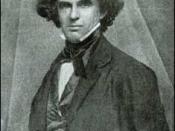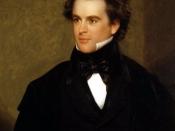Flowers are thought to be beautiful and breathtaking, but Rappaccini's garden is something deadly and evil. It's certainly breathtaking, but while one is there, it may be the last breath taken. Rappaccini (antagonist) was a fine scientist, but just like it's said in the story, "he cares infinitely more for science than for mankind" (5). The conflict is, why would such a wonderful scientist forget about his whole career to attend to his beloved garden? Why would he make his beautiful daughter Beatrice (protagonist) immune to the poison and make it impossible to be in love with Giovanni (the young student living in the old edifice)? The twisted and dark story of "Rappaccini's Daughter" by Nathaniel Hawthorne definitely covers almost every aspect of Dark Romanticism. These are all examples of negative imagery, gothic elements, and harmful nature relations shown throughout the story and how Dark Romanticism is very much present.
"Rappaccini's Daughter," uses a great number of negative imagery. I found over 13 of them. In the story it is said that as Rappaccini was in his garden he was "...emaciated, sallow, and sickly-looking" (2). Emaciated means to be very thin especially from disease, hunger or cold. This is negative imagery because it describes Rappaccini in a horrible way. Also, in the story, it describes his garden as something "...ugly and monstrous" (6). This is negative in a sense that it shows that his garden is not only dark and twisted but at the same time he is also. These were only a few of the examples of negative imagery used in the story.
Dark Romanticism has a lot to do with gothic elements. In "Rappaccini's Daughter," it demonstrates many examples of Gothicism. Gothic means something very mysterious, and desolate. An example from...


